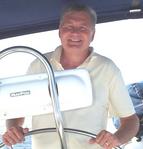Overheating Engine
Tag: engine
An overheating diesel is usually the result of one of three conditions: either the engine is working harder than normal (possibly due to a clogged or defective injector), the supply of cooling water has been reduced, or the thermostat is failing to open. The actual temperature of the cooling water will also affect your engine’s operating temperature but this is a change that usually occurs gradually as the season progresses.
The seawater loop is relatively simple and easy to troubleshoot. The loop is made up of a seawater strainer, a water pump, heat exchanger, mixing elbow and muffler, which is all connected with hose. A properly operating cooling system will exhaust approximately 6-8 GPM at 2,000 RPM. A bucket at the engine exhaust port is a good way to measure the output. If the output is significantly less than the volumes mentioned above, try this 4 step process to isolate the area that has the problem.
1. The most likely cause is a flow reduction before the water pump. Check the easy items first: intake seacock position, seawater strainer, and intake thruhull. The later can be check by removing the hose from the seacock and using a wood dowel to ream out any debris. Your dinghy’s airpump is also an effective tool for dislodging clogs, weeds, plastic bags, or whatever might be impeding flow. Check the vented loop in the port lazarette making sure there are no salt crystals on the ‘duckbill’ valve.
2. Next you should check the seawater pump/impeller, belt tension, hose and hose clamps. Make sure that none of the hose clamps have been applied too far back on the hoses which may have restricted the inside diameter of the hose. A minor reduction in size will significantly reduce the volume of water flow. The condition of the impeller vanes (especially cracking) might not be noticeable until you remove it from the housing. If nothing is found, connect a length of heater hose to the output of the water pump and measure the output by discharging the water into the bucket while running the engine briefly. If the output is still significantly less than the desired volume mentioned above, go back over everything. You may have to check each piece of hose for an obstruction.
3. If flow from the pump is OK, it is necessary to determine if the seawater side of the heat exchanger is restricted. Connect a hose to the output of the heat exchanger and measure the output by discharging the water into the bucket while running the engine briefly. If the volume is significantly less than the amount measured in step 2, the heat exchanger is probably restricted. Debris or a buildup of minerals most commonly causes the restriction. The heat exchanger can be removed and cleaned at most radiator ships or you can attempt an in-place treatment with distilled white vinegar drawn in via the strainer and allowed to sit for a few days.
4. If the output of the heat exchanger is proper but the overboard discharge is still low, the mixing elbow or muffler is probably causing a restriction. Check for obstructions in the hose and nipple that connect to the mixing elbow. If that doesn’t help, pull the mixing elbow itself and check for carbon buildup.
- Karl Mielenhausen, Silver Lining, #690 with input from Jim Delong, McGeeves, #453 and David Marecek, Island Dream, #1007


What's Related